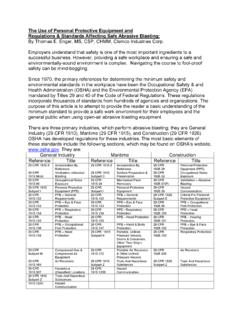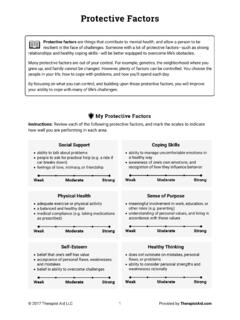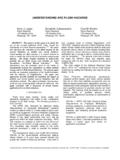Transcription of Understanding the return on health, safety and ...
1 Economic Evaluation Proceedings PaperUnderstanding the return on health , safety and environmental investmentsJoanne B. Linhard*ORC Worldwide, Suite 810, 1800 K Street, NW, Washington, DC 20006, 202-293-2980, United StatesAbstractIntroduction:Traditionally , health safety and environmental (HS & E) investments have been viewed as expensive but necessary. HS &E professionals had a difficult task of providing data showing that these investments can also contribute to business success. An ORC taskforce developed a way for traditional financial analysis methods to be applied to HS & E investments and :The result ofthe task force effort is the software called the ORC return on health , safety and environmental Investments (ROHSEI), a supporting tool toprovide a comprehensive look at health , safety or environmental investment projects and their potential financial :Since itsdevelopment, more than 200 companies, government agencies, and educational institutions have been trained in the ROHSEI process.
2 HS & E professionals who are able to evaluate and communicate the business value of health , safety andenvironmental efforts will improve Understanding of the impacts HS & E projects and contribute to better decision making by National safety Council and Elsevier Ltd. All rights :Environment; health ; safety ; Workplace; Financial; Metrics1. IntroductionIn today s fast-paced and competitive environment, allcomponents of business organizations are being asked todemonstrate their value to the organization. Traditionally, health , safety and environmental (HS & E) investmentshave been looked upon as being expensive, but necessaryto avoid costly government citations. Therefore, improve-ments or innovations in health , safety and environmentalbeyond what is necessary to meet compliance obligationswere often delayed and actual business benefits ofexpenditures for HS & E were not examined.
3 Others haveresisted the notion of using financial metrics in connectionwith HS & E decision-making, feeling that businessoperational decisions would always take priority overproactive or innovative HS & E projects. Still others(especially those in the HS & E professions) who have hadlittle or no formal training in the process of making abusiness case for HS & E, found the financial termsconfusing or feared that the estimates they developedwould not be based on analyses sufficiently sophisticatedto withstand scrutiny by the mid-1990 s, however, a task force of 15 ORCW orldwide Occupational safety and health Group membercompanies set themselves to the task of developing a wayfor traditional financial analysis methods to be applied toHS & E investments and decisions.
4 The result is the processand software called the ORC return on health , safety andEnvironmental Investments or MethodROHSEI is a process and supporting tool set developedfor use by occupational health , safety and environmentalprofessionals and others to provide a comprehensive look atinvestment decisions and to answer important questions,such as: What health and safety or environmental investmentsshould we make? When should we make a particular investment ?0022-4375/$ - see front matterD2005 National safety Council and Elsevier Ltd. All rights * Tel.: +1 202 293 of safety Research - ECON proceedings 36 (2005) 257 Which health and safety or environmental investmentscreate the greatest value to the organization? How do we compare an operational investment decisionto a HS & E decision?
5 How do we know we are doing the right things in the right way ? To which projects should we allocate our humanresources? How can we demonstrate the business value of ourinvestment decisions?The ROHSEI process facilitates and encourages a teamapproach and calculates financial metrics in a commonlanguage. It also facilitates an Understanding of how changein one part of a business has an effect on the overallbusiness. It is of great value to the HS & E professionalwhen assessing capital and expense investment decisionssuch as material selections, capacity expansion, programdevelopment investment , resource allocation, trainingapproaches, and risk management ROHSEI useThe metrics understood by today s HS & E profes-sionals ( , lost workday injury and illness rates,property loss, worker_s compensation costs, fines andcitations, number of people trained, exposure assessments,near misses, behavioral observations, and audit findings)
6 Are often not well understood by those responsible forapproving or planning company business , traditionally HS & E professionals were nottrained to use the metrics most often used by businessfinancial and operations personnel ( , earnings, earn-ings per share, return on investment , payback period,internal rate of return , return on shareholder equity,production rates, salary progression, inventory turnover,etc.).ROHSEI facilitates a team approach to understandingand translating these seemingly unrelated sets of metricsand toward promoting investment decisions that reflect amore complete Understanding of the impacts both on anorganization s health , safety and environmental goals aswell as on its business and financial goals. ROHSEI helps improve HS & E performance by helping organ-izations make better decisions and by helping HS & Eto become integrated into an organization s The ROHSEI processROHSEI is a four-step process that guides the HS & Eprofessional in building and communicating a businesscase for addressing virtually any type of safety , health orenvironmental four steps are:1.
7 Understand the Opportunity or Challenge2. Identify and Explore Alternative Solutions3. Gather Data and Conduct Analysis4. Make a Understanding the opportunity or challengeInvestments are always made for some purpose: toincrease revenues, to decrease costs, to improve productiv-ity, to reduce injuries, to comply with regulations, and soforth. An important starting point for all individualsinvolved with developing a business case, whether brain-storming alternatives, gathering data, making assumptions,formulating recommendations, or making decisions, is tohave a solid Understanding of the objectives, requirements,and constraints of the investment ROHSEI toolset_sBusiness Case Summaryis usedto document the specific definition of the investmentopportunity.
8 First, it asks the user to describe the focus ofan opportunity or challenge. That is, what is the problemthat needs to be addressed? Is the project being conducted toreduce risk, reduce costs, and/or increase revenue? If thepurpose includes reducing risk, it allows the user to describethe current risk level and explain why this level isunacceptable. Typical examples of opportunities or chal-lenges that HS & E manager might want to conduct aROHSEI analysis for are: (a) determining the business valueof buying newer, faster, safer process equipment versuscontinuing with existing equipment but upgrading thecompany s personal protective equipment program andincreasing employee hazard avoidance training; (b) deter-mining whether to increase staff to take over a short termdisability case management function in-house versus use ofan external contractor.
9 And (c) determining whether todesign and make changes to reduce risk factors in anoperation despite the fact that few employee complaintshave been received and no employee injuries have Identifying and exploring alternative solutionsIn this step, ROHSEI users define the current situationand document their immediate ideas for responding to theopportunity or challenge presented. The analysis team(although ROHSEI can be used by individuals, it isrecommended that more than one person participate) isencouraged to brainstorm beyond these initial ideas toensure that all reasonable alternatives are reviewed. Thebrainstorming activity may also spark innovative ideasabout alternatives that "push the envelope" of analysis team prioritizes the alternatives to beevaluated, based on the ability of each alternative to addressthe objectives, requirements, and constraints of the Linhard / Journal of safety Research - ECON proceedings 36 (2005) 257 260258tunity.
10 Examples of questions the team should addressduring this phase are: Does this opportunity fit within thecompany_sorgroup_s business strategy; what are therequirements and constraints that must be met by theinvestment alternative to pursue the opportunity; and whatfactors will influence a reviewer s decision. Once areasonable set of alternative investment scenarios isdeveloped, each is documented in Step 2 of the BusinessCase Summary Gather data and conduct analysisThe next step is to encourage the analysis team todevelop a comprehensive view of how each of thealternative investments impacts business , the process facilitates the consideration of boththedirectandhiddenbenefits, as well as direct and hiddencosts of each investment impactsaredefined as those impacts that are easily quantified andclearly observable, such as health and safety personnel time,production downtime, loss of raw materials, and health andsafety capital.













![PROTECTIVE SERVICES [NP-5] BARGAINING UNIT …](/cache/preview/6/c/f/6/f/1/1/4/thumb-6cf6f1149d89c2f122cf7097d1d511b9.jpg)


